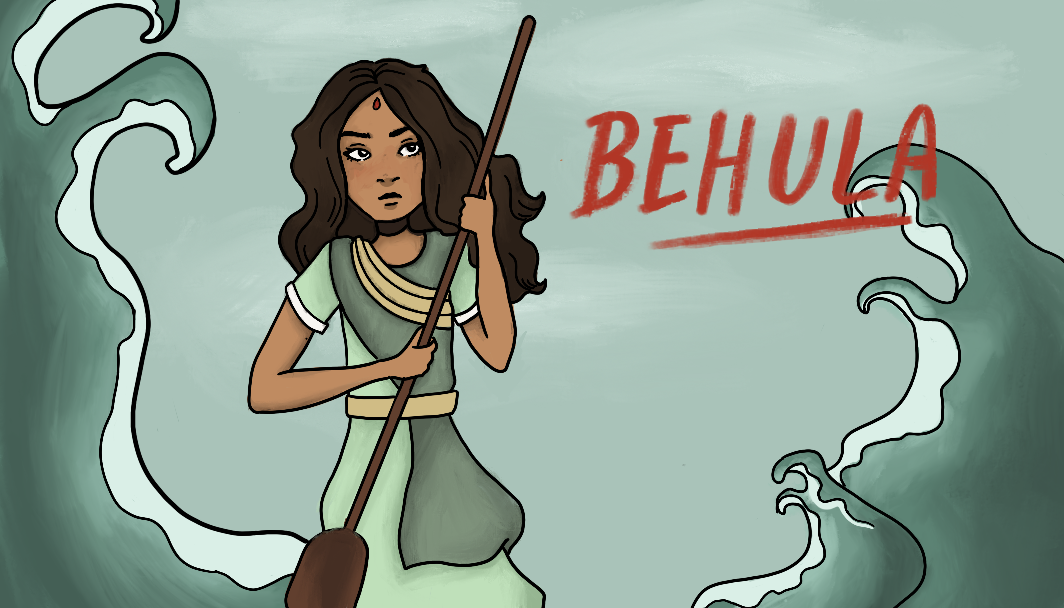Some of my fondest memories with my mom from when I was still little were when I’d watch Bengali soaps with her every weekday after I finished my homework. She would take my workbook in one hand and the TV remote on the other. Then we’d settle down on the couch with a bowl of puffed rice and watch Behula. We’d watch every episode and she’d give commentary on what was true to the book and what wasn’t. Watching my mom relax for that one hour after working tirelessly all day and then be so excited about a story she read when she was a child, it was special.
There are many stories about the Hindu snake gods and goddesses in the Bengal region. Among all of them, the most popular and widely told tale is that of Behula and the snake goddess Manasa. The story originates from the helplessness that people felt from the number of deaths that occurred every year due to snake bites, especially during the monsoon season (the rainy season). The myth goes that thousands of years ago, Manasa did not yet have any devotees. So, she asked Chand, a prominent merchant to be her first worshipper. Chand, who at that time worshipped the Lord Shiva, refused this offer. This enraged Manasa and she promised to destroy everything he had. A goddess’s promise is not something to take lightly, however, Chand was adamant on not giving in to Manasa’s threats.
Manasa followed through with her promise. She destroyed everything he owned and sent snakes to kill his six sons on their wedding nights. Devastated but still unwilling to give in, Chand rebuilt his business and mansion, and eventually remarried. He was blessed with a son again, his name was Lakhindar. However, Manasa’s curse had not yet lifted. Lakhindar grew up and fell in love with Behula, a sweet natured beautiful girl who was his childhood friend. He wanted to get married to her in spite of knowing about the curse that Manasa would kill him on the wedding night. In order to prevent this, Chand ordered an architect to build his son a house of iron that would be impenetrable by snakes. However, Manasa got a hold of the architect first and made him leave a hole in one of the walls of the house.
After getting married, Behula and Lakhinder moved into this house of iron and on that very night, Manasa sent her most powerful snake to kill Lakhinder when he was asleep. Behula was devastated by her husband’s death and was unable to accept it. At the time, victims of snake bite would be put on to a raft and floated off into the river in hopes that their bodies would reach heaven or a snake charmer would be able to revive them. Behula got on the raft with her husband’s body, breaking away from her family who tried to physically restrain her from doing so. She was going to get to heaven and beg for her husband’s life. Her journey had seven stages and each stage came with different obstacles that Behula had to overcome. It showed that this sweet natured and soft girl was also strong and resilient. No matter what the goddess Manasa threw on to her journey, Behula persevered. She finally made it to heaven and upon performing and dancing for the goddess, Manasa agreed to give back Lakhinder’s life if his father, Chand would pledge his loyalty to her. Behula went back home and convinced her father-in-law to end the rivalry with Manasa. Chand, finally gives up and it brings Lakhinder back to life. And they are said to have lived happily ever after.
There are many renditions of this folktale, but one thing remains consistent – Behula’s nerves of steel. It’s a story where a woman saves a man and not the other way round. Behula refused to be a damsel in distress and took her fate into her own hands. Now, that’s one admirable heroine.
Author: Protiva Iqbal
Editor: Gwendolyne Cheung
Illustrator: Roos de Waard


